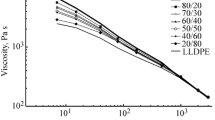Abstract
The mechanical and dynamic mechanical properties of isotactic polypropylene/high density polyethylene (PP/HDPE) blends, as a function of blend ratio and compatibiliser concentration were analysed. Ethylene propylene random copolymers (EPDM) with three different monomer fractions were used as compatibilisers. Compatibilisation improved the mechanical properties (except Young’s modulus) of the blends, considerably. The compatibiliser with 1:1 monomer fraction was found to be most efficient. A detailed discussion on the fundamental reasons responsible for the deterioration of properties in the absence of compatibilisers and the improvement of properties in the presence of compatibilisers was presented. The tensile strength of the uncompatibilised blends was theoretically modelled using Nielsen’s and Nicolais-Narkis models. The Young’s and storage moduli of uncompatibilised blends were compared with those predicted by various theoretical models. Attention was paid to correlate the mechanical properties of both compatibilised and uncompatibilised blends with their phase morphology.
















Similar content being viewed by others
References
Utracki LA (2002) Introduction to polymer blends. In: Utracki LA (ed) Polymer blends handbook, vol 1. Kluwer Academic Publishers, Dordrecht
Sundararaj U, Macosko CW (1995) Drop Breakup and Coalescence in Polymer Blends: The Effects of Concentration and Compatibilization. Macromolecules 28:2647–2657
Harrats C, Fayt C, Jérôme R (2002) Effect of block copolymers of various molecular architecture on the phase morphology and tensile properties of LDPE rich (LDPE/PS) blends. Polymer 43:863–873
Soares BG, Moreira ACF, Sirqueira AS, Barbosa RB, Simao RA (2008) Effect of Molecular Architecture of Graft Copolymers on the phase morphology and tensile properties of PS/EVA blends. J Appl Polym Sci 107:930–938
Wang J-J, Li Z-Z, Xue-Ping G, Feng L-F, Zhang C-L, Guo-Hua H (2012) A dissipative particle dynamics study on the compatibilising process of immiscible polymer blends with graft copolymers. Polymer 53:4448–4454
Cerclé C, Favis BD (2012) Modified interfacial tensions measured in situ in ternary polymer blends demonstrating partial wetting. Polymer 53:4338–4343
Kuriakose B, De SK, Bhagawan SS, Sivaramkrishnan R, Athithan SK (1986) Dynamic mechanical properties of thermoplastic elastomers from polypropylene–natural rubber blend. J Appl Polym Sci 32:5509–5521
Karger Kocsis J, Kiss L (1987) Dynamic mechanical properties and morphology of polypropylene block copolymers and polypropylene/elastomer blends. Polym Eng Sci 27:254–262
Varghese H, Bhagavan SS, Rao SS, Thomas S (1995) Morphology, mechanical and viscoelastic behaviour of blends of nitrile rubber and ethylene-vinyl acetate copolymer. Eur Polym J 31:957–967
George J, Varughese KT, Thomas S (2000) Dynamically vulcanised thermoplastic elastomer blends of polyethylene and nitrile rubber. Polymer 41:1507–1517
John B, Varughese KT, Oommen Z, Thomas S (2003) Dynamic mechanical behavior of high-density polyethylene/ethylene vinyl acetate copolymer blends: The effects of the blend ratio, reactive compatibilization, and dynamic vulcanization. J Appl Polym Sci 87:2083–2099
Vargas ER, Arellano ZS, Valdez JSH, Colunga JGM, Valdes SS (2006) Compatibility of HDPE/postconsumer HDPE blends using compatibilizing agents. J Appl Polym Sci 100:3696–3706
Diaz MF, Barbosa SE, Capiati NJ (2006) Addition compatibilization of PP/PS blends by tailor-made copolymers. Polym Eng Sci 46:329–336
Moly KA, Bhagawan SS, Groeninckx G, Thomas S (2006) Correlation between the morphology and dynamic mechanical properties of ethylene vinyl acetate/linear low-density polyethylene blends: effects of the blend ratio and compatibilisation. J Appl Polym Sci 100:4526–4538
Borah JS, Chaki TK (2011) Dynamic rheological, morphology and mechanical properties of compatibilized LLDPE/EMA blends. J Polym Res 18:907–916
Rajan KP, Al-Ghamdi A, Ramesh P, Nando GB (2012) Blends of thermoplastic polyurethane (TPU) and polydimethyl siloxane rubber (PDMS), part-I: assessment of compatibility from torque rheometry and mechanical properties. J Polym Res 19:1–13
Divya VC, Pattanshetti VV, Suresh R, Sailaja RRN (2013) Development and characterisation of HDPE/EPDM-g-TMEVS blends for mechanical and morphological properties for engineering applications. J Polym Res 20:51
Chevallier C, Becquart F, Taha M (2013) Polystyrene/polycarbonate blends compatibilisation: Morphology, rheology and mechanical properties. Mater Chem Phys 139:616–622
Choi P, Blom HP, Kavassalis TA, Rudin A (1995) Immiscibility of poly(ethylene) and poly(propylene): a molecular dynamics study. Macromolecules 28:8247–8250
Rajasekaran JJ, Curro JG, Honeycutt JD (1995) Theory for the Phase Behavior of Polyolefin Blends: Application to the Polyethylene/Isotactic Polypropylene Blend. Macromolecules 28:6843–6853
Moly KA (2005) Ph D Thesis, Mahatma Gandhi University
Nielsen LE (1966) Simple theory of stress–strain properties of filled polymers. J Appl Polym Sci 10:97–103
Nicolais L, Narkis M (1971) Stress–strain behaviour of styrene-acrylonitrile/glass bead composites in the glassy region. Polym Eng Sci 11:194–199
George J (2004) Ph D Thesis, Mahatma Gandhi University
Coran AY, Coran AY (1988) In: Bhowmick AK, Stephens HL (eds) Handbook of elastomers, new developments and technology. Marcel Dekker, New York
Dickie RA (1973) Heterogeneous polymer–polymer composites. I. Theory of viscoelastic properties and equivalent mechanical models. J Appl Polym Sci 17:45–63
Holsti-Miettinen RM, Seppala JV, Ikkala OT, Reima IT (1994) Functionalized elastomeric compatibilizer in PA 6/PP blends and binary interactions between compatibilizer and polymer. Polym Eng Sci 34:395–404
Author information
Authors and Affiliations
Corresponding author
Rights and permissions
About this article
Cite this article
Jose, S., Thomas, S., Biju, P.K. et al. Mechanical and dynamic mechanical properties of polyolefin blends: effect of blend ratio and copolymer monomer fraction on the compatibilisation efficiency of random copolymers. J Polym Res 20, 303 (2013). https://doi.org/10.1007/s10965-013-0303-5
Received:
Accepted:
Published:
DOI: https://doi.org/10.1007/s10965-013-0303-5




